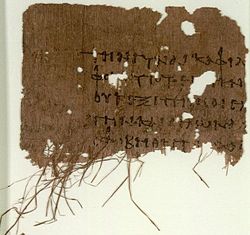Matthew 13
| Matthew 13 | |
|---|---|
 Gospel of Matthew 13:55–56 on Papyrus 103, from c. AD 200. | |
| Book | Gospel of Matthew |
| Category | Gospel |
| Christian Bible part | New Testament |
| Order in the Christian part | 1 |
| Gospel of Matthew |
|---|
|
Chapters |
Matthew 13 is the thirteenth chapter in the Gospel of Matthew in the New Testament section of the Christian Bible. Verses 3 to 52 of this chapter form the third of the Five Discourses of Matthew, called the Parabolic Discourse, based on the parables of the Kingdom.[1]
Description[]
Matthew 13 presents seven parables,[2] and two explanations of his parables. At the end of the chapter, Jesus is rejected by the people of his hometown, Nazareth.
The chapter contains the following parables, in respective order:
- Parable of the Sower
- Parable of the Tares
- Parable of Drawing in the Net
- Parable of the Mustard Seed
- Parable of the Leaven
- Parable of the Hidden Treasure
The following explanations of the first two parables are included:
- Explanation of the Parable of the Sower
- Explanation of the Parable of the Tares
Protestant theologian Heinrich Meyer identifies two groups of parables: the four first parables (up to Matthew 13:34) "were spoken in presence of the multitude, and the other three again within the circle of the disciples".[3] German liberal Protestant theologian David Strauss thought this chapter was "overwhelming with parables".[4] At the beginning of the chapter, Jesus sits in a ship or a boat on the Sea of Galilee and addresses the crowd who stand on the shore or the beach.[5] The Textus Receptus has inserted the definite article (Greek: τὸ πλοῖον, to ploion), suggesting that there was a boat kept waiting for him,[6] but other texts do not include the definite article and the Pulpit Commentary therefore argues that it was "wrongly inserted".[7]
Text[]

The original text was written in Koine Greek. This chapter is divided into 58 verses.
Textual witnesses[]
Some early manuscripts containing the text of this chapter are:
- Papyrus 103 (~AD 200; extant verses 55-56)
- Codex Vaticanus (325-350)
- Codex Sinaiticus (330-360)
- Codex Bezae (~400)
- Codex Washingtonianus (~400)
- Codex Ephraemi Rescriptus (~450)
- Codex Purpureus Rossanensis (6th century)
- Codex Petropolitanus Purpureus (6th century; extant verses 5-32, 42-58)
- Codex Sinopensis (6th century; extant verses 7-47, 54-58)
Old Testament references[]
Structure[]
This chapter can be grouped (with cross references, where there are parallels, to the other gospels):
- Matthew 13:1–9 = Parable of the Sower (Mark 4:1–20; Luke 8:4–15)
- Matthew 13:10–17 = Reason for Parables
- Matthew 13:18–23 = Parable of the Sower explained (Mark 4:1–20; Luke 8:4–15)
- Matthew 13:24–30 = Parable of the Tares (Mark 4:26–29)
- Matthew 13:31–32 = Parable of the Mustard Seed (Mark 4:30–32; Luke 13:19–21)
- Matthew 13:33–35 = Parable of the Leaven (Luke 13:20–21)
- Matthew 13:36–43 = Parable of the Tares explained
- Matthew 13:44 = Parable of the Hidden Treasure
- Matthew 13:45–46 = Parable of the Pearl
- Matthew 13:47–50 = Parable of Drawing in the Net
- Matthew 13:51–52 may be called a "comparative proverb" [9] or a "solemn conclusion to the parables.[2]
- Matthew 13:53–58 = Jesus is rejected in Nazareth (Mark 6:1–6; Luke 4:16–30)
See also[]
- Leaven
- Mustard seed
- Parables of Jesus
- Pearl
- Tare
- Related Bible parts: Matthew 25, Mark 4, Mark 6, Luke 4, Luke 8, Luke 13
References[]
- ^ Preaching Matthew's Gospel by Richard A. Jensen (1998). ISBN 978-0-7880-1221-1. pp. 25 and 158.
- ^ a b Alford, H., Greek Testament Critical Exegetical Commentary - Alford on Matthew 13, accessed 25 February 2021
- ^ Meyer, H. A. W., Meyer's NT Commentary on Matthew 13, published 1880, accessed 13 January 2017
- ^ Meyer, H., Meyer's NT Commentary on Matthew 13, accessed 13 January 2017
- ^ Matthew 13:2
- ^ Bengel, J. A., Bengel's Gnomon on Matthew 13, accessed 13 January 2017
- ^ Pulpit Commentary on Matthew 13, accessed 13 January 2017
- ^ Kirkpatrick, A. F. (1901). The Book of Psalms: with Introduction and Notes. The Cambridge Bible for Schools and Colleges. Vol. Book IV and V: Psalms XC-CL. Cambridge: At the University Press. p. 839. Retrieved February 28, 2019.
- ^ Allison, D. Jr., Matthew in Barton, J. and Muddiman, J. (2001), The Oxford Bible Commentary, p. 862
External links[]
 Media related to Gospel of Matthew - Chapter 13 at Wikimedia Commons
Media related to Gospel of Matthew - Chapter 13 at Wikimedia Commons- Matthew 13 King James Bible - Wikisource
- English Translation with Parallel Latin Vulgate
- Online Bible at GospelHall.org (ESV, KJV, Darby, American Standard Version, Bible in Basic English)
- Multiple bible versions at Bible Gateway (NKJV, NIV, NRSV etc.)
| Preceded by Matthew 12 |
Chapters of the New Testament Gospel of Matthew |
Succeeded by Matthew 14 |
- Gospel of Matthew chapters